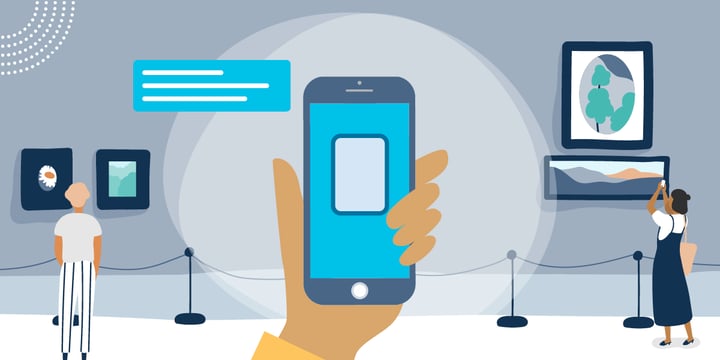Today we are only just scratching the surface of what artificial intelligence (AI) is capable of accomplishing. AI is already seen in fields like commerce, security, and manufacturing, just to name a few. However, using AI in educational settings is a great way to revolutionize teaching and learning. Specifically, AI can be applied in educational spaces like museums. Because museums are heavily reliant on the work of volunteers, it is difficult to have staff members continuously answering questions and engaging with visitors.

Although the concept of artificial intelligence can seem complex, it can perhaps be best understood by breaking down the term itself. At its core, AI is a branch of computer science that is related to creating programs or machines that are capable of performing tasks that normally require human intelligence. In other words, AI is simply the simulation of human intelligence in machines. These machines and software programs are programmed to mimic humanlike actions and thoughts. Specifically, they are designed to replicate human traits that are related to problem-solving and learning.
The skill of being able to think like humans is extremely valuable — especially for nonprofit organizations in which staff can be scarce at times. But with AI, some of these roles can be autonomous — such as with chatbots. That's right: chatbots are an example of AI that's used every day.
Here are a few uses of AI that are revolutionizing the way people experience museums today.
The Power of Image Classification
Deep learning is a branch of AI that is concerned with constructing programs that replicate the human brain. These programs, called neural networks, are programmed to learn by example and then formulate their own conclusions based on these learnings.
For example, the process of training a neural network would involve feeding a program a large amount of data like images of food. When the programmer first shows the program these images, the images have labels like "salad," "pizza," or "burger." After seeing hundreds or thousands of these images, the program can identify other images of food that don't have labels. Here is a demonstration of a deep learning program that classifies images of objects in space.
By using deep learning, museums can create programs that classify artwork, dinosaur bones, or any other museum objects and provide information about them. For example, the Barnes Foundation Museum in Philadelphia has developed a smartphone app that uses image recognition to improve visitor experience.
The app is able to recognize any piece of art by even a small segment because it was trained with hundreds or thousands of images of each art piece.
Once it recognizes a piece, the app provides the name, artist, history, and facts about the piece right from the visitor's phone. This reduces the need for the museum to clutter its building with signs and nametags, which not only improves the aesthetic of the museum but also promotes a more streamlined visitor experience. A visitor who is not familiar with impressionist art can distinguish artworks from one another and find more information about them, all without manually looking them up in a physical pamphlet or online.
Virtual Reality
Virtual reality refers to a computer-generated simulation of a three-dimensional environment. Users of VR can interact with this generated simulation through sight and sound, and in most cases, a VR experience can react to users' body motions. VR creates a simulation through three main components: a viewing system, motion sensors, and interactivity elements. The viewing system is the typical headset that people wear to view the simulation. The motion sensors are placed around the area where the simulation will take place and where they can detect movements by the user. The interactivity elements include handheld controllers or sensors that detect hand and arm motions and replicate them in the simulation.
Incorporating VR in museums would allow visitors to have a more engaging and educational visit. For example, Paris' Louvre launched a VR program, Mona Lisa: Beyond the Glass. This 8-minute simulation takes the visitor back in time to when the Mona Lisa was first painted and brings the woman in the painting to life. Throughout the simulation, the visitor learns about the background of the painting, the woman, and the artist. The VR experience provides an alternate method of viewing art — a method that is more captivating and educational.
Speech Recognition
A branch of AI that many people have experience with is speech recognition. Whether it is using Siri on your iPhone or asking your Google Home what the weather is, speech recognition might be the most commonly recognized branch of artificial intelligence.
In its simplest terms, speech recognition software works by breaking down human speech into individual sounds, analyzing those individual sounds, and then using algorithms to determine what word or phrase best fits that sound. Much like image recognition programs, educational institutions can use speech recognition to understand and answer visitor questions.
A case study by the Museum of Modern Art in New York examined the potential uses of voice recognition in public educational attractions such as museums. Some of the use cases that the researchers studied included the implementation of a speech recognition program near a group of artworks, which would allow for visitors to have their general questions answered by voice, rather than using their phone to search the Internet. Minimizing phone usage throughout the museum also allows the visitor to stay in the moment while roaming the museum.
The study also looked at how voice recognition programs could improve accessibility options for visitors who are visually impaired. With a means of spoken interaction, visitors can have pieces of art verbally described. Although many museums do not have permanent voice recognition software implemented in their exhibits currently, studies show that it has great upside. The ability to interact with art and exhibits enhances the museum experience for all visitors by emphasizing the art itself and reducing distractions like phones.
AI: Improving Visitor Experiences at Modern Museums
AI is already revolutionizing how museums operate. It provides museums and other educational institutions with many other ways to deliver on their missions. Image classification is transforming how visitors learn about art. Integrating AI software like image classification apps in art museums increases learning as it allows visitors to engage with artwork in new ways.
Further, virtual reality is redefining the limits of interacting with the history behind pieces of art. Introducing VR experiences reduces the stigma of museums being antiquated and instead provides a much more exciting method of learning about art. Lastly, speech recognition is magnifying the way visitors can interact with museums. Speech recognition software reduces the need for visitors to look up information on their phones, which influences them to stay present in the museum and interact with the artwork more. The digital age is upon us, with most industries modernizing themselves. AI allows museums to digitize themselves without losing their traditional educational mission.
Additional Resources
- Read about an Otter.ai user's experience with this AI transcription software.
- Find out What Chatbots Can Do for Nonprofits: Top 5 Things.
- Watch a webinar on The Third Wave of Nonprofit Technology: Technology for Social Change.
- Take Power Apps 101: How to Easily Build Apps from TechSoup Courses.
Top photo: Shutterstock







